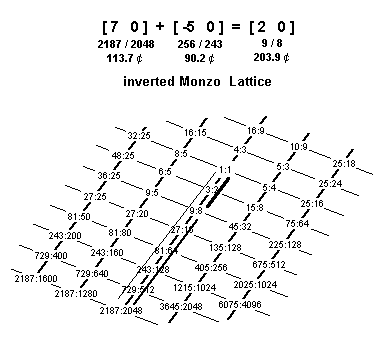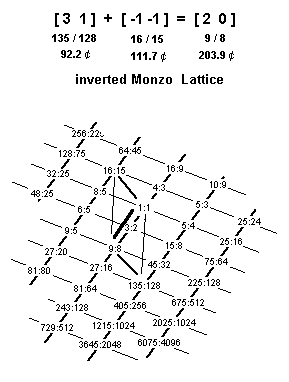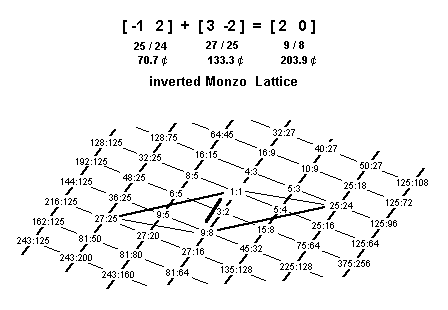(This is a detailed analysis of a discussion in my HEWM notation definition.)
Pythagorean tuning has two types of semitone: the "diatonic" of about 90 cents (also called "limma"), and the "chromatic" of about 114 cents (also called "apotome").
5-limit Just-Intonation, on the other hand, because it is 2-dimensional, provides a myriad of different sizes for both of the semitones, depending on which exponents of prime-factor 5 are involved in the composition of the ratios.
On the lattice diagrams below, I use three different thickness of lines to represent the vectors of the different intervals. The thinnest line is the vector for the "chromatic semitone", the medium-thickness line is for the "diatonic semitone", and the thickest line is for the "whole-tone". In all cases it is plain to see how adding the two different semitones, in either order, always results in the 9:8 "whole-tone" [2 0].
First, here is the structure in Pythagorean tuning, which is the basis of our notation:

Here are two different pairs of 5-limit "chromatic" and "diatonic" semitones:


There are many more examples, but these three are the most relevant, as they are the closest to the center of the lattice, and thus the most likely to be used or implied in typical diatonic musical pieces.
In any temperament in which the syntonic comma vanishes -- such as meantone, well-temperament, or an equal-temperament which such as 12, 19, 24, 26, 31, 36, 38, 43, 45, 50, and 55edo -- the tempering-out of this interval has the effect of broadening the meaning of # and b so that it may imply any of the 5-limit combinations, including the three illustrated above.
So these intervals are all functionally identical in these types of tunings, and so, depending on the harmonic context, # and b can "mean" an intonational inflection by any of these 5-limit intervals.
This is an important consideration for anyone who studies the standard repertoire, because it applies for the vast majority of music in the standard Euro-centric repertoire, which never distinguishes this interval in notation, so that A is always simply A, B is always simply B, etc.
[from Joe Monzo, JustMusic: A New Harmony]